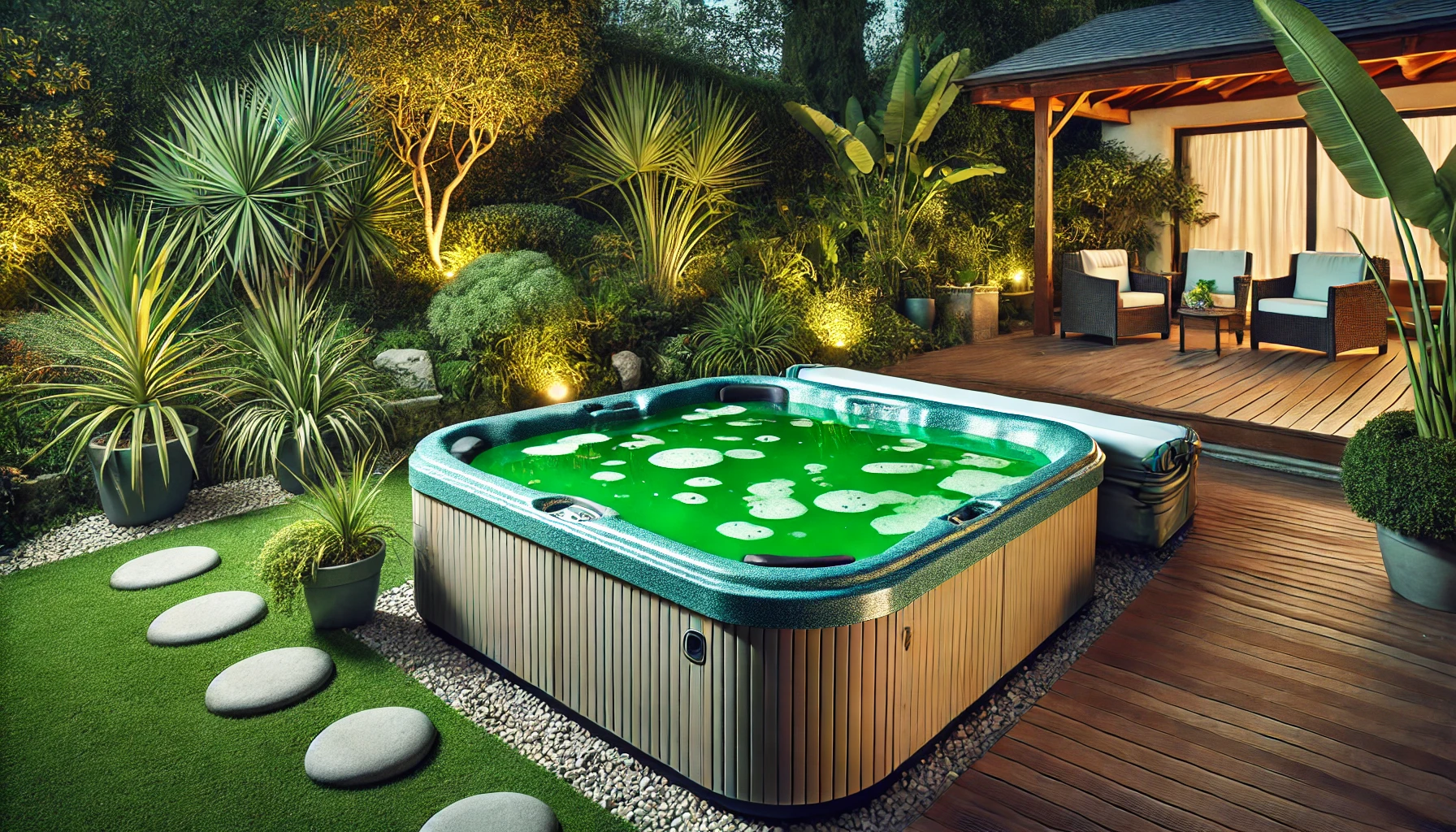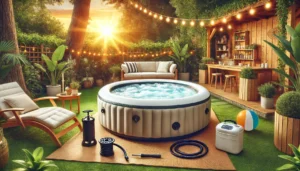Imagine this: it’s a crisp evening, and you’re looking forward to a relaxing soak in your hot tub. You lift the cover, ready to slip into the warm, bubbly water, but wait—what’s that? The water has turned an alarming shade of green!
Yikes! I’ve been there, my friend, and let me tell you, it’s not the most inviting sight. But don’t worry, green hot tub water is a common issue that we can tackle together.
In this article, I’ll share my experiences and the knowledge I’ve gained over years of hot tub ownership to help you understand why this happens and how to fix it. Trust me, with a little know-how, you’ll have your hot tub sparkling clean in no time!
Why Is My Hot Tub Water Green?
Oh boy, I remember the first time I saw my hot tub water turn green – talk about a panic moment! I thought I’d have to drain the whole thing and start from scratch.
But before we jump into solutions, let’s talk about why this happens in the first place. Green hot tub water is typically caused by algae growth, which thrives in warm, nutrient-rich environments.
It’s like a tiny underwater jungle in there! Algae spores are constantly present in the air and can easily find their way into your hot tub.
Once they’re in, if conditions are right, they can multiply faster than you can say “cannonball!” Now, you might be wondering, “But I keep my hot tub clean! How did this happen?”
Well, algae growth often occurs when there’s an imbalance in your water chemistry, particularly when sanitizer levels are low or pH is improper. It’s like leaving the door unlocked – those algae spores are just waiting for an opportunity to move in and set up shop.
Sometimes, though, the green color isn’t due to algae at all. It can be caused by metal oxidation, especially copper.
This was a real head-scratcher for me when I moved to a new house with well water. The water looked clean coming out of the tap, but as soon as it hit my hot tub – bam! – Shrek’s swamp.
Turns out, the high mineral content in my well water was the culprit. Don’t worry though, whether it’s algae or metals, it’s totally fixable!
We’ll dive deeper into the causes and solutions below, but remember – prevention is key to keeping your hot tub crystal clear and inviting.
Common Causes of Green Hot Tub Water
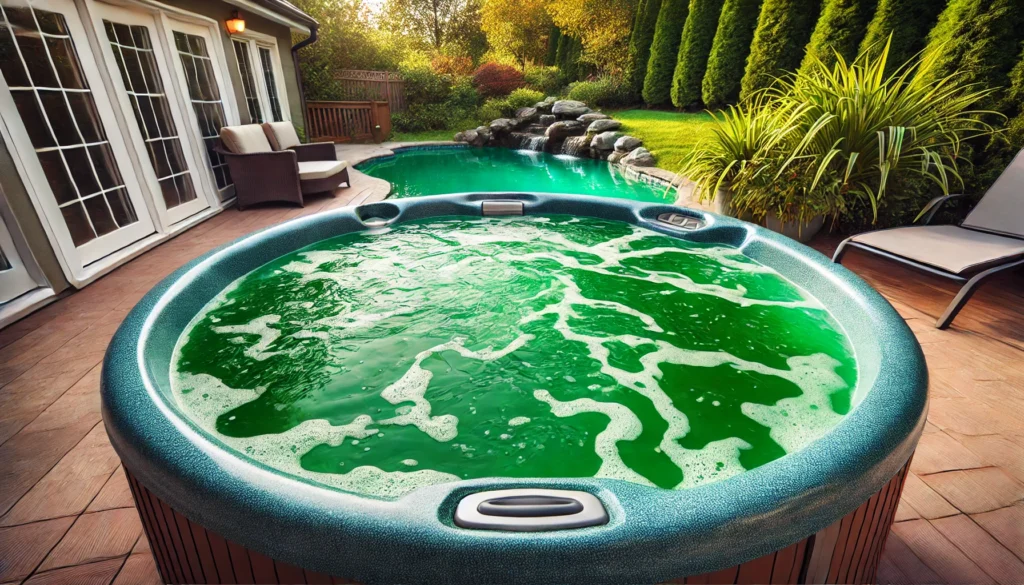
Let’s break down the usual suspects behind that unsightly green tinge.
First up, and the most common culprit, is algae growth. And boy, can it be persistent!
Algae are like that cousin who comes to visit and never leaves – they love warm, stagnant water and can bloom rapidly if your sanitizer levels drop. There are actually different types of algae that can invade your hot tub.
Green algae are the most common, but you might also encounter yellow (mustard) algae or even the dreaded black algae. Each type requires slightly different treatment, but we’ll get to that later.
Then there’s the issue of imbalanced pH levels. I once let my pH levels get way out of whack, and it was like rolling out the red carpet for algae.
You see, when pH is off, your sanitizer becomes less effective. It’s like trying to clean your house with a feather duster – it’s just not going to cut it.
Ideally, your hot tub’s pH should be between 7.2 and 7.8. Anything above or below this range can cause problems.
Another tricky cause can be copper oxidation. If you have high copper content in your water (often from well water or old pipes), it can oxidize and turn your water green.
I learned this the hard way when I moved to a new house with well water. The first time I filled up my hot tub, I thought I was cultivating a science experiment!
Copper can enter your hot tub water through source water, corroded heaters, or even certain algaecides. Lastly, insufficient sanitizer levels can be a big problem.
Chlorine or bromine are your first line of defense against algae and bacteria. If these levels drop, it’s like leaving your front door wide open to uninvited guests!
I once went on vacation and forgot to add extra sanitizer before I left. Let’s just say, I came back to a hot tub that looked more like a pond than a relaxing oasis.
But wait, there’s more! Sometimes, the problem isn’t just one of these factors, but a combination.
It’s like a perfect storm of conditions that turn your crystal-clear hot tub into a murky mess. That’s why it’s crucial to regularly test and maintain your water chemistry.
How to Identify the Specific Cause of Green Water
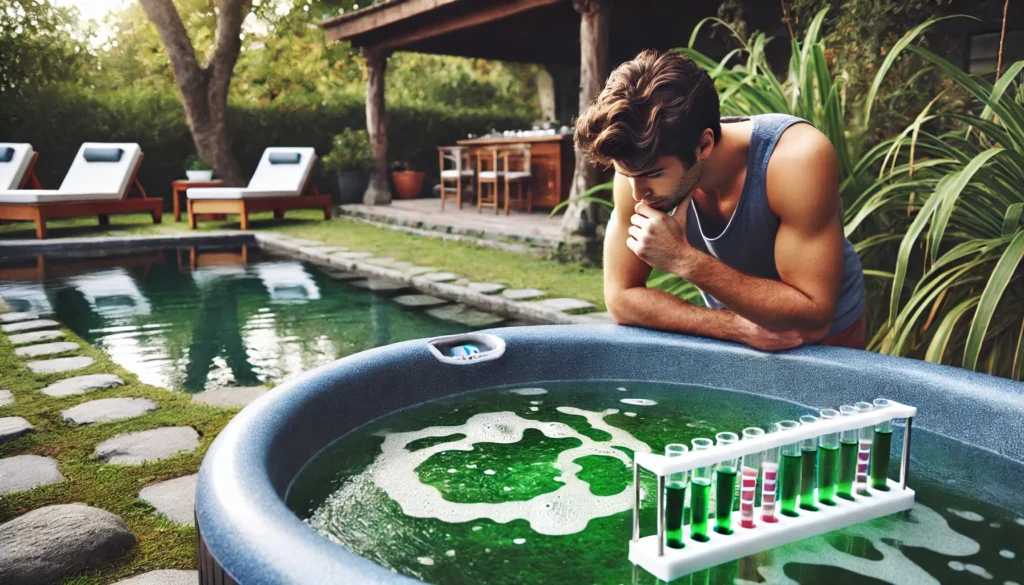
Alright, detective time! Here’s how you can narrow down what’s causing your green water woes.
Start with a visual inspection. Take a good look at your water.
Is it a deep, murky green (likely algae) or more of a light, transparent green (possibly metals)? If it’s algae, you might notice a slimy feeling on the sides of the tub or floating particles in the water.
If it’s metals, the water might look clear but tinted green, and you might see staining on the tub surfaces. Next, testing your water chemistry is crucial!
Grab those test strips and check your pH, alkalinity, and sanitizer levels. I keep mine right next to the hot tub for quick checks.
Here’s what you’re looking for:
- pH: Should be between 7.2 and 7.8
- Alkalinity: Aim for 80-120 ppm
- Free Chlorine: 3-5 ppm
- Bromine: 4-6 ppm
If your pH is high and your sanitizer levels are low, you’ve got perfect conditions for algae growth. On the other hand, if everything looks good but you still have green water, you might be dealing with metals.
It’s also important to consider recent maintenance and usage patterns. Did you forget to add sanitizer after a big party?
Has it been raining a lot, potentially throwing off your water balance? Think back to any recent changes or events.
I once had a green water issue after a particularly windy day – turns out, a bunch of leaves had blown into the tub and started decomposing, throwing off my water chemistry. Don’t forget to check your filter too.
A dirty or clogged filter can’t do its job properly, allowing contaminants to build up in your water. I learned this lesson the hard way when I got lazy about cleaning my filter – let’s just say, it wasn’t pretty.
If you’re still unsure, you might want to take a water sample to your local pool and spa store. They often offer free water testing and can give you a more detailed analysis of what’s going on in your hot tub.
Steps to Clear Green Hot Tub Water
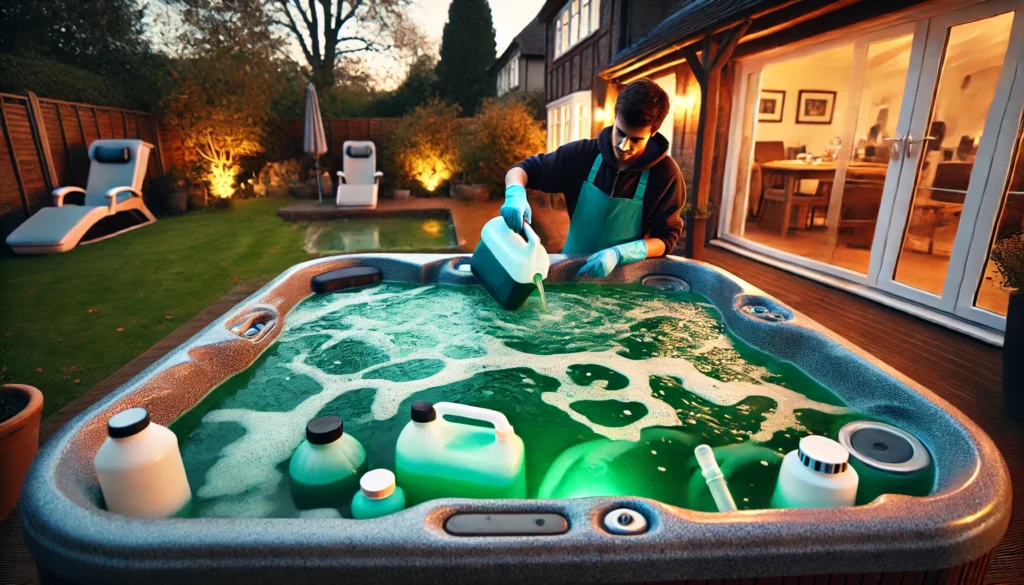
Time to roll up our sleeves and get that water crystal clear again!
Your first line of attack should be a shock treatment. I like to do this in the evening and let it work overnight.
Add a strong dose of chlorine or non-chlorine shock to kill off any algae or bacteria. How much?
Well, that depends on your tub size and the severity of the problem, but a good rule of thumb is to double the normal dose. Just be sure to follow the instructions on the product label.
After shocking, run your jets for at least 30 minutes to circulate the shock treatment throughout the entire system. This helps ensure that the shock reaches all areas of your tub, including the pipes where algae might be hiding.
Once the shock has done its job (usually after about 24 hours), test and adjust your pH and alkalinity levels. Remember, we’re aiming for a pH between 7.2 and 7.8, and alkalinity between 80-120 ppm.
This might take a bit of trial and error, but don’t get discouraged. It’s like seasoning a soup – a little bit at a time until it’s just right.
If you’re dealing with a stubborn algae bloom, an algaecide can be your best friend. Follow the instructions carefully – more isn’t always better!
In fact, using too much algaecide can cause foaming issues, and nobody wants a bubble bath in their hot tub (well, maybe some people do, but that’s a different story). Now, let’s talk filters.
Don’t forget about these unsung heroes! They’ve been working overtime trapping all that gunk.
Give them a good clean or replace them if they’re looking worse for wear. I like to keep a spare filter on hand so I can swap it out and give the dirty one a thorough cleaning.
If you suspect metals are the cause of your green water, you’ll need to use a metal sequestrant. This product binds to the metals in your water, preventing them from oxidizing and causing discoloration.
Just be aware that this can affect your water chemistry, so you’ll need to test and adjust accordingly. For really stubborn cases, you might need to drain and refill your hot tub.
I know, I know, it’s a pain, but sometimes it’s the best way to start fresh. Plus, it gives you a chance to give your tub a good scrub down.
Just be sure to clean and flush your pipes before refilling to prevent any lingering algae from recontaminating your fresh water. Remember, patience is key here.
It might take a couple of days to see crystal clear results, but stick with it! Rome wasn’t built in a day, and your hot tub won’t be cleaned in one either.
Preventing Green Water in Your Hot Tub
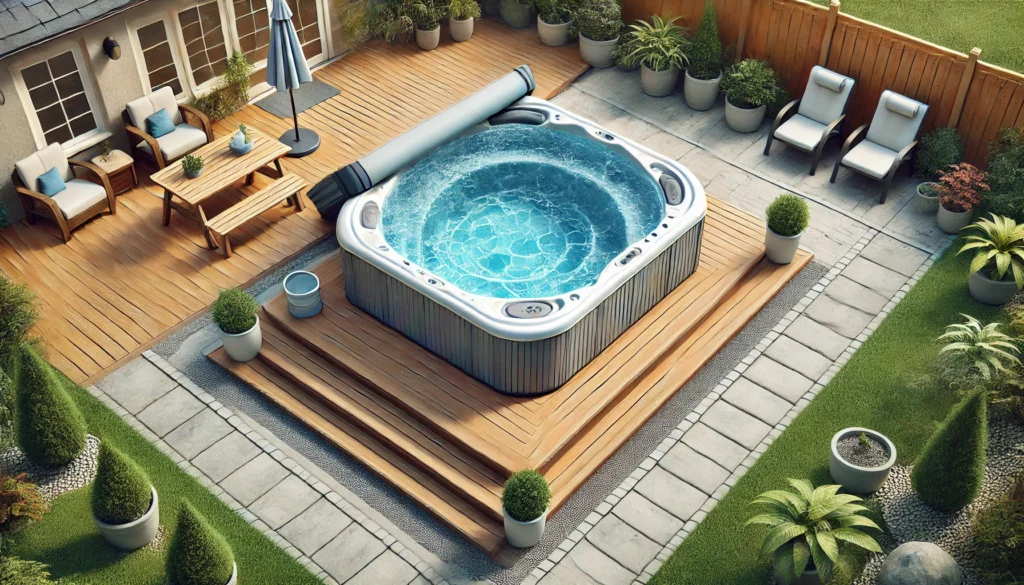
An ounce of prevention is worth a pound of cure, right? Here’s how to keep that green menace at bay.
First, establish a regular maintenance schedule. I set reminders on my phone to check and adjust my water chemistry weekly.
It’s a small time investment that pays off big time! Test your water at least 2-3 times a week, and adjust as needed.
It might seem like overkill, but trust me, it’s much easier to maintain balanced water than to fix a full-blown algae bloom. Keeping proper chemical balance is crucial.
Maintain your sanitizer, pH, and alkalinity levels in check. It’s like a balanced diet for your hot tub.
I like to think of chlorine (or bromine) as the bouncer at a club – it keeps the riffraff (bacteria and algae) out. But the bouncer can’t do its job if the pH is off, so keep that in check too.
Good circulation is key to preventing algae growth, so run your pump for at least 4-6 hours a day. Some people run their pumps 24/7, which is great if you can afford the electricity bill.
If not, consider investing in a circulation pump that runs continuously but uses less energy. Don’t underestimate the importance of your hot tub cover.
Always cover your hot tub when not in use. It keeps debris out and reduces chemical loss due to evaporation.
Plus, it saves on energy bills – win-win! Just make sure to clean your cover regularly too.
A dirty cover can drip contaminants back into your clean water every time you open it. Regular cleaning is also crucial.
Wipe down your hot tub’s shell and jets weekly to prevent biofilm buildup. This slimy layer can harbor bacteria and make it harder for your sanitizer to do its job.
And don’t forget about your filters – clean them monthly and deep clean them quarterly. Lastly, consider using enzymes in your hot tub.
These little workhorses break down organic contaminants like body oils and lotions that can feed algae. Think of them as the cleanup crew, working alongside your sanitizer to keep things sparkling clean.
When to Seek Professional Help
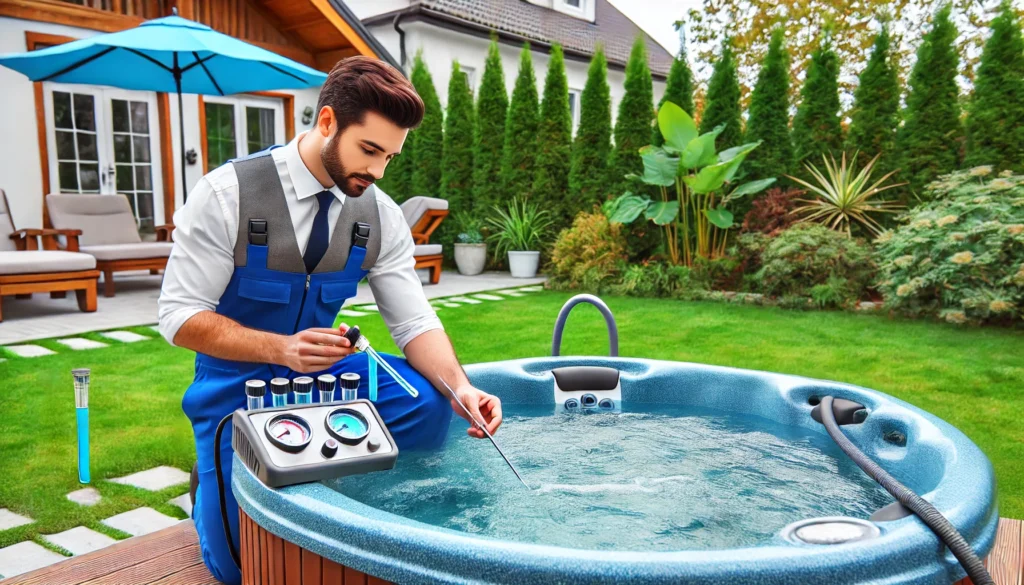
Look, we all like to think we’re hot tub wizards, but sometimes you gotta know when to call in the cavalry.
If you’ve tried everything and that green tinge just won’t budge, it might be time for an expert opinion. Sometimes, especially with well water, you might be dealing with mineral issues that are beyond home testing capabilities.
A pro can do more advanced water testing and help you get to the root of the problem. If you suspect your pump, heater, or other equipment might be contributing to the problem, don’t try to be a DIY hero.
Call in a pro to avoid potentially costly mistakes. I once thought I could fix a small leak in my heater.
Let’s just say, it didn’t end well, and I ended up paying a lot more for repairs than if I’d called a professional in the first place. It’s also a good idea to get professional help if you’re dealing with recurring algae problems.
They might be able to spot issues with your equipment or maintenance routine that you’ve overlooked. Plus, they often have access to more powerful treatments that aren’t available to the average hot tub owner.
Remember, it’s better to be safe than sorry when it comes to complex water chemistry problems or equipment malfunctions. Your hot tub is an investment, and sometimes spending a little on professional help can save you a lot in the long run.
Conclusion
Whew! We’ve covered a lot of ground, haven’t we? Green hot tub water can be a real bummer, but armed with this knowledge, you’re well-equipped to tackle it head-on.
Remember, consistency is key in hot tub maintenance. A little regular TLC goes a long way in preventing these issues from cropping up in the first place.
Don’t let a little green water discourage you from enjoying your hot tub oasis. With proper care and quick action when issues arise, you’ll be back to soaking in crystal clear waters in no time.
And hey, next time you encounter this problem, you’ll be the hot tub guru in your neighborhood! Hot tub maintenance might seem like a chore, but I like to think of it as a labor of love.
After all, there’s nothing quite like sinking into warm, clean water after a long day. It’s your own personal retreat, your backyard spa, your stress-melting machine.
A little effort to keep it in top shape is well worth the relaxation and enjoyment it brings. So, what are your experiences with green hot tub water?
Any tried-and-true tips you’d like to share? Drop a comment below – I’d love to hear your hot tub tales and tricks!
And remember, every hot tub owner has dealt with water issues at some point. You’re not alone in this bubbly journey.
Stay bubbly, my friends, and here’s to crystal clear waters and relaxing soaks in your future!
